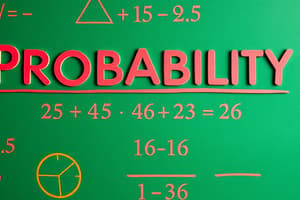Podcast
Questions and Answers
Which of the following best describes the role of probability in managing uncertainty?
Which of the following best describes the role of probability in managing uncertainty?
- It increases uncertainty by introducing more variables.
- It eliminates uncertainty by providing exact predictions.
- It ignores uncertainty, focusing only on certain outcomes.
- It quantifies uncertainty, allowing for informed decision-making. (correct)
A probability of 1 indicates an impossible event.
A probability of 1 indicates an impossible event.
False (B)
Which probability framework is most suitable when historical data is readily available?
Which probability framework is most suitable when historical data is readily available?
- Theoretical Probability
- Subjective Probability
- Frequency-Based Probability (correct)
- Classical Probability
When is subjective probability most often used?
When is subjective probability most often used?
Probability is expressed on a scale from ______ to 1.
Probability is expressed on a scale from ______ to 1.
What is a key application of probability in business?
What is a key application of probability in business?
Match the following probability frameworks with their defining characteristic:
Match the following probability frameworks with their defining characteristic:
Decision trees utilize probabilities and outcomes to calculate expected values.
Decision trees utilize probabilities and outcomes to calculate expected values.
In a decision tree, what do chance nodes represent?
In a decision tree, what do chance nodes represent?
Write the formula for calculating expected value given two scenarios
Write the formula for calculating expected value given two scenarios
Which of the following describes events that are mutually exclusive?
Which of the following describes events that are mutually exclusive?
Drawing two cards from a deck without replacement are independent events.
Drawing two cards from a deck without replacement are independent events.
According to the multiplication rule, the probability of two independent events both occurring is found by ______ their individual probabilities.
According to the multiplication rule, the probability of two independent events both occurring is found by ______ their individual probabilities.
Explain the addition rule when events are not mutually exclusive.
Explain the addition rule when events are not mutually exclusive.
If P(A) = 0.4 and P(B) = 0.3, and A and B are mutually exclusive, what is the probability of either A or B occurring?
If P(A) = 0.4 and P(B) = 0.3, and A and B are mutually exclusive, what is the probability of either A or B occurring?
Flashcards
Probability
Probability
A numerical measure of the likelihood of an event occurring, ranging from 0 (impossible) to 1 (certain).
Classical Probability
Classical Probability
Probability based on known and predefined possible outcomes.
Frequency-Based Probability
Frequency-Based Probability
Probability based on observed data or past occurrences.
Subjective Probability
Subjective Probability
Signup and view all the flashcards
Application of Probability
Application of Probability
Signup and view all the flashcards
Decision Tree
Decision Tree
Signup and view all the flashcards
Decision Nodes
Decision Nodes
Signup and view all the flashcards
Chance Nodes
Chance Nodes
Signup and view all the flashcards
Probabilities (in decision trees)
Probabilities (in decision trees)
Signup and view all the flashcards
Outcomes (in decision trees)
Outcomes (in decision trees)
Signup and view all the flashcards
Expected Value
Expected Value
Signup and view all the flashcards
Mutually Exclusive
Mutually Exclusive
Signup and view all the flashcards
Independent Event
Independent Event
Signup and view all the flashcards
Multiplication Rule (probability)
Multiplication Rule (probability)
Signup and view all the flashcards
Addition Rule (probability)
Addition Rule (probability)
Signup and view all the flashcards
Study Notes
- Describes and manages uncertainty, expressed on a scale from 0 to 1, or 0% to 100%.
- 0 indicates impossibility, while 1 indicates certainty.
- Example: a coin flip has a 0.5 (50%) probability of heads.
Three Probability Frameworks
- Classical Probability: Relies on predefined possible outcomes.
- Example: A coin flip has a 1/2 chance of heads, and rolling a die has a 1/6 chance for any number.
- Frequency-Based Probability: Based on observed data.
- Example: Batting averages in baseball and side effects of well-studied medicines.
- Subjective Probability: Utilizes expert judgment when data is unavailable or outdated.
- Example: Estimating project overruns or potential side effects of new experimental medicines.
Application of Probability
- Assists in both business and personal decision-making processes.
- Estimates risks, predicts outcomes, and enables informed choices.
Decision Trees
- Decision trees combine decision nodes, chance nodes, probabilities, and outcomes to calculate expected values.
- Average outcome = Probability (of scenario 1) x value of outcome + Probability (of scenario 2) x value of outcome
Additional Language of Probability
- Mutually Exclusive: Events that cannot occur simultaneously.
- Example: When rolling a 6-sided die, the event of rolling an even number and the event of rolling an odd number are mutually exclusive.
- Independent Event: An event where the probability remains unaffected by other events.
- Example: Rolling a die multiple times are independent events.
- Dependent event Example: Drawing two cards from a deck of cards without replacing them is not independent.
- Multiplication Rule: Determines the probability of independent events occurring together by multiplying their probabilities.
- Example: The probability of tossing a coin and rolling 2 heads in a row is 0.5 x 0.5 = 0.25.
- Addition Rule: Calculates the probability of either one event or another occurring.
- When dealing with mutually exclusive events, simply add the probabilities together to find the probability that one or the other happens.
- Example: The probability of drawing a heart OR diamond card if you draw a random card from a deck is: 0.25 + 0.25 = 0.5
- For events that aren't mutually exclusive, add the probabilities together and then subtract out the number that fall into both camps.
- Example: the probability of drawing an ace OR a diamond would be: 13/52 + 4/52 - 1/52 = 16/52 = 0.31, probability of a diamond plus the probability of an ace minus the probability of the ace of diamonds.
Studying That Suits You
Use AI to generate personalized quizzes and flashcards to suit your learning preferences.




